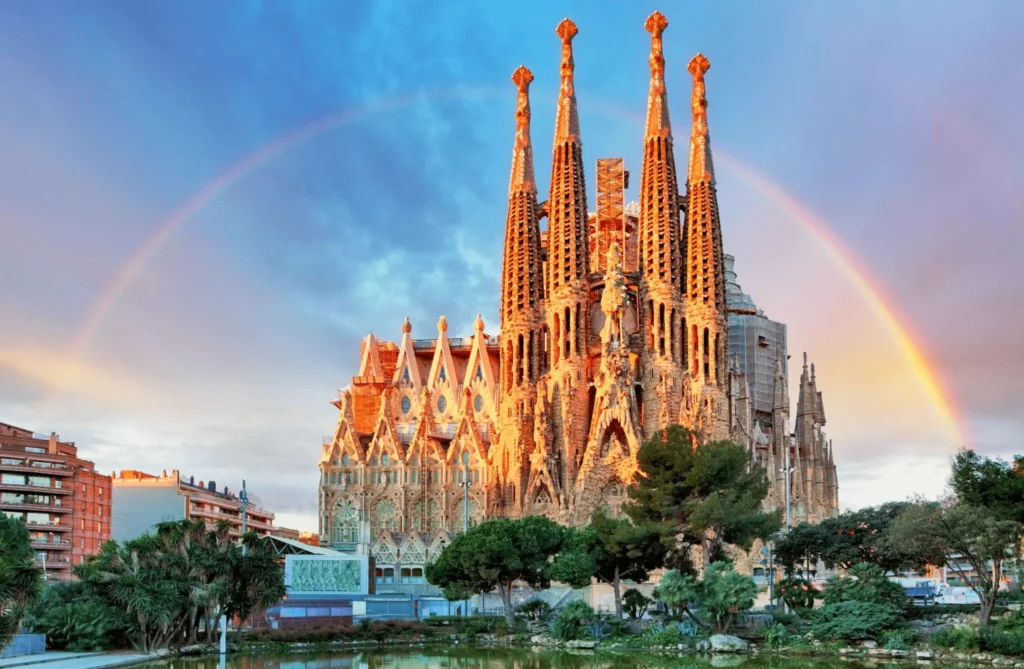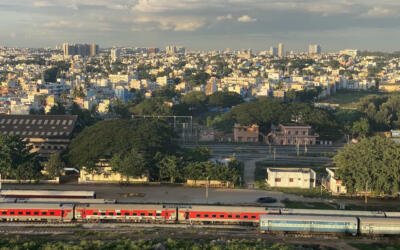Looking for your next destination in Spain? Barcelona is a popular destination with many ex-pats touring Spain. Besides its rich history, architecture, and culture, the city’s beautiful beaches and climate make it a popular tourist destination.
Table of Contents
- 1 The history of Barcelona
- 2 What makes Barcelona a major tourist attraction?
- 3 Visa application
- 4 Cost of living and cost of living arbitrage
- 5 Crypto Community
- 6 Size of Expat community in Barcelona
- 7 Popular recreational activities and fun spots in Barcelona
- 8 Transportation in Barcelona
- 9 Safety
- 10 Cultural and social norms
- 11 Barcelona’s Political and economic stability
- 12 Language and language barriers
- 13 Healthcare in Barcelona
- 14 Electronic standards
- 15 Telephone and Internet plans
- 16 Payment service and infrastructure
- 17 Climate and seasons
- 18 Cuisine in Barcelona
- 19 Tax requirements on digital nomads
- 20 Common concerns about Barcelona
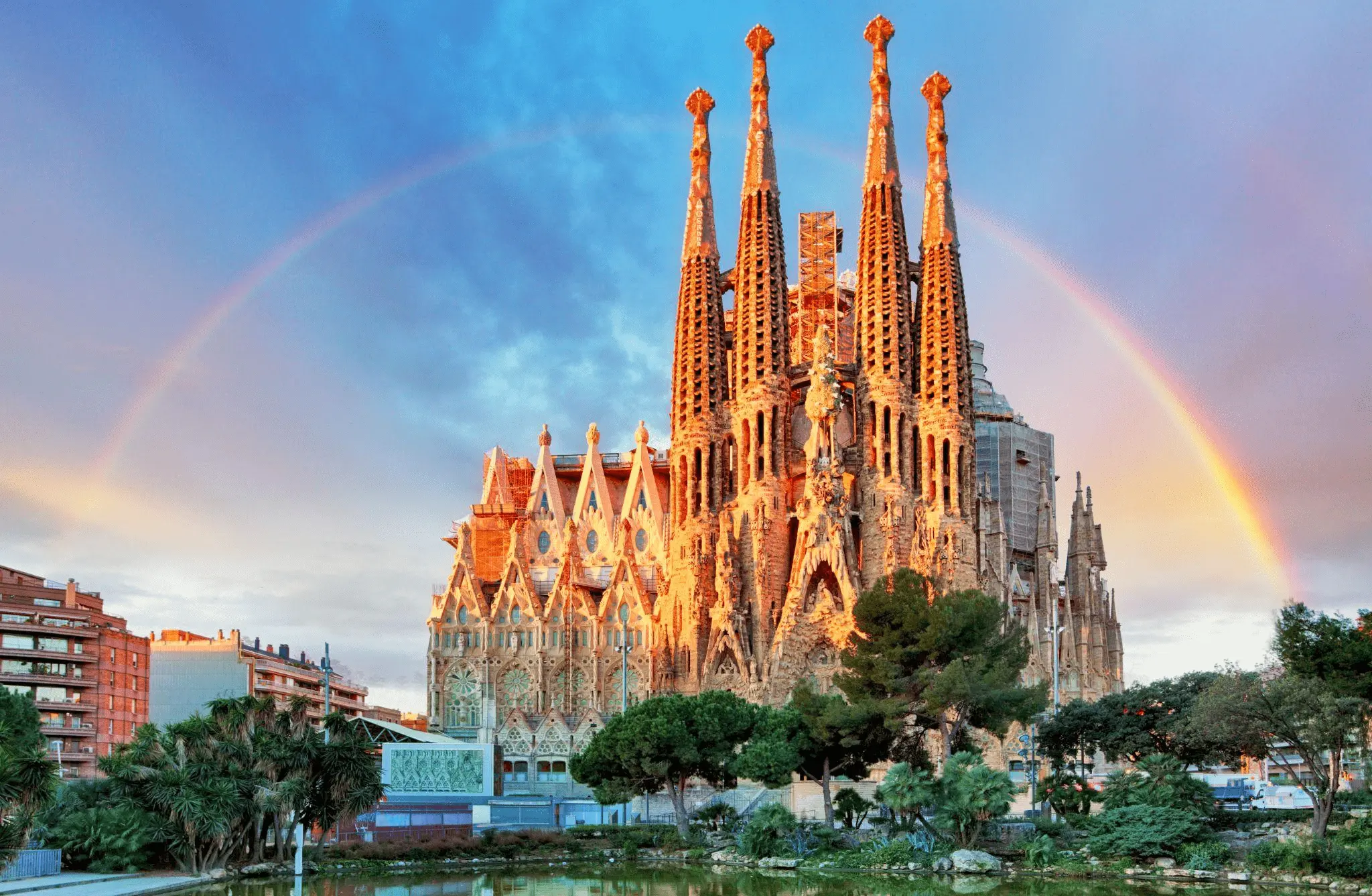
After Madrid, Barcelona is the second biggest city in Spain. The city has a population of about 5.6 million and receives over 8 million visitors annually.
For digital nomads, Barcelona offers the right environment. These include convenient coworking spaces and reliable accommodations options.
The history of Barcelona
Barcelona has a long history that goes as far back as the mythology of Hercules. Although the earliest settlement of present-day Barcelona remains unknown, some of the ruins of the early settlement still exist. These ruins date back to the early 5000 BC. Also, the locals believe the founding of Barcelona was thanks to two legends, Hercules and Hamilcar Barca (Father to Hannibal). They also believe that Hamilcar named the city Barcino after his family.
The 15th to 18th century period saw Barcelona enter into a long struggle to maintain its political and economic stability. In 1714, this struggle ended with the House of Bourbon (the reigning monarchy) coming to power. During the mid-19th century, Barcelona started its cultural recovery thanks to the emergence of the textile industry.
In the 20th century, Barcelona ushered urban renewal. This led to the rise of some of the world’s widely known architectural buildings. These buildings include Casa Batllo, Sagrada Familia, and Casa Mila by Antoni Gaudi, a famous architect.
However, the Civil War of 1936 led the city to lose its glory. It, however, recovered and experienced major growth during General Franco’s (Spain’s dictator 1939 -1975) economic miracle. The city hosted the 1992 Olympic Games, cementing it as a major global city.
What makes Barcelona a major tourist attraction?
For several reasons, Barcelona is one of Europe’s most visited and well-known cities. Some of the reasons for this fame are;
1. Barcelona Football Club (Barca)

Barcelona FC is one of the most popular football clubs in the world, with over 269 million fans. Founded in 1899, this football club holds many football records. These records include five times UEFA Champions League winners, over thirty-time winners of Cope del Rey, and 26 times winners of the Spanish La Liga premier league.
On top of the records, the football club has had impeccable players like Lionel Messi, Andreas Iniesta, Diego Maradona, Pep Guardiola, and many others.
The Camp Nou Stadium is the home stadium of Barcelona FC. This stadium is the largest in Europe, with a capacity of about 100,000 people. This football team also has a museum which houses the club’s history. The Camp Nou Stadium and the Museum attract over 2 million visitors annually.
2. Sandy beaches
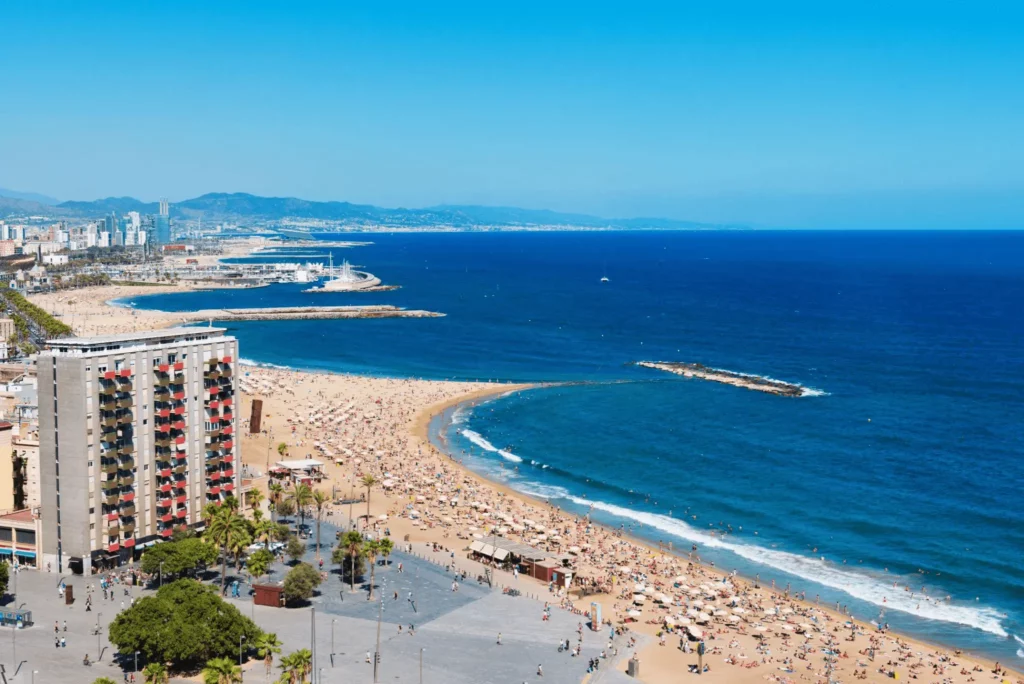
Being a coastal city, Barcelona has long sandy beaches, which are popular with tourists. Barceloneta, initially a popular fishing ground, is the most popular beach in Barcelona. Along the beach sides, there are several cafes, bars, and restaurants where people can enjoy a meal or a drink.
Barcelona has a long coastline stretching about four kilometers with over nine beautiful beaches. Interestingly, most of the beaches in Barcelona are man-made, thanks to the 1992 Barcelona Olympics. In preparation for this event, the government spent millions of Euros constructing beaches, a yachting marina, and five-star hotels.
Since then, sand has been added to these beaches, thus creating one of the most attractive features for tourists in the city.
3. Architecture
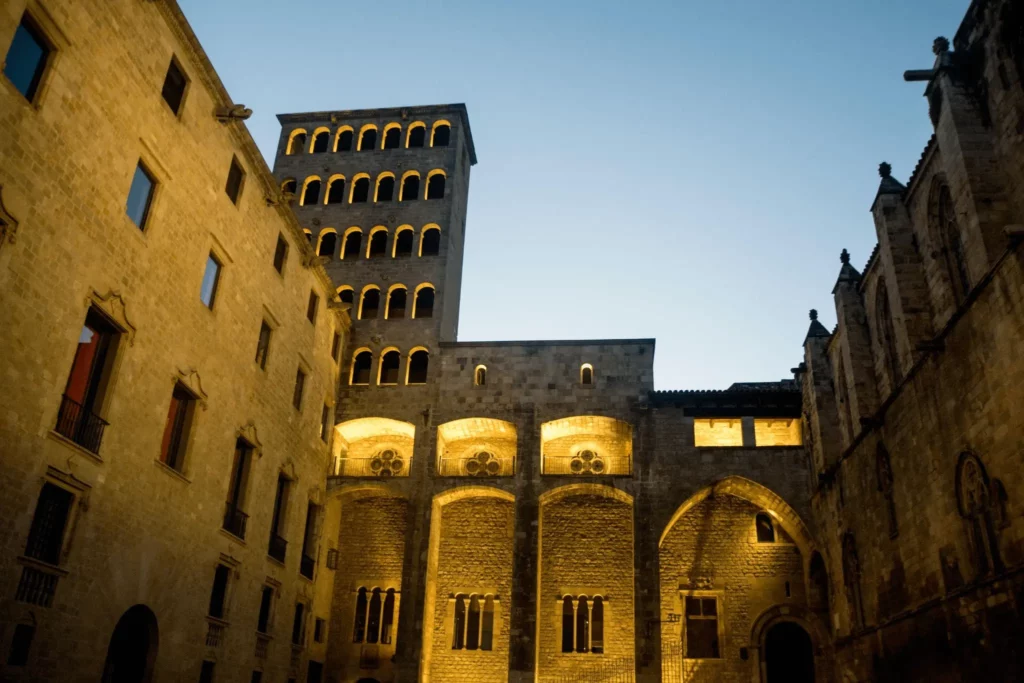
There are still ruins of the original Roman buildings in the city. However, medieval buildings replaced some of them.
Some popular medieval buildings include Santa Maria del Mar, Royal Palace (Palau Major), Pedralbes Monastery, and the Barcelona Cathedral.
Barcelona is also known for its Modernist architecture built between the late nineteenth and early twentieth century. Most of these buildings were commissioned by Rich industrialists who earned their fortune during the industrial revolution. These modernist buildings include El Palau de la Musica, Casa Batllo, Casa Amatller, and La Sagrada Familia.
Some of the best architects of that era include Antoni Gaudi, Lluis Domenech I Montaner, and Josep Puig l Cadafalch.
Apart from medieval and modernist architecture, Barcelona also has some attractive modern architecture. Some notable modern buildings include the Mies van der Rohe’s Barcelona Pavilion, the DHUB Museum, Agbar Tower, and the Golden Fish Canopy by Frank Gehry.
4. Favorable climate

Barcelona shares the same latitude as Rome and Chicago; thus, it experiences a mild winter climate. Also, the city experiences an average of 2,500 sunshine hours throughout the year. During summer, spring, and autumn, the weather is conducive for tourists, and it rarely rains. During these times, Barcelona receives many tourists that love to enjoy outdoor activities.
Visa application
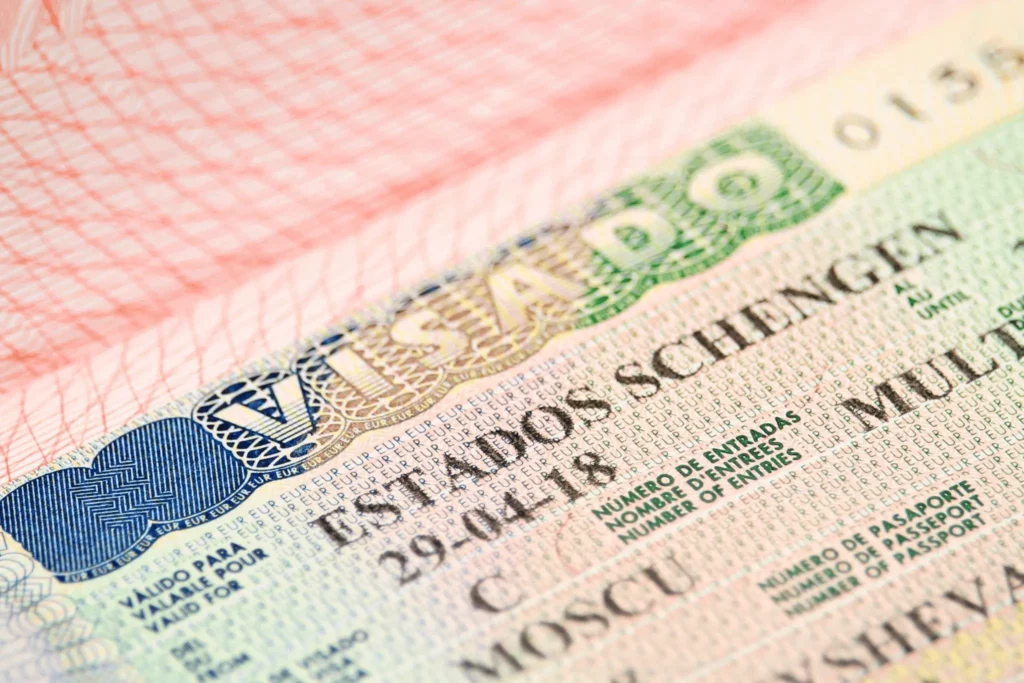
Spain issues visitors with both short-stay and long-stay visas. Short-stay visas are mainly for those visiting family members, vacationing, and touring. Short-stay travelers have to acquire a Schengen Visa.
A Schengen Visa allows short-stay travelers to enter countries that are members of the Schengen zone. This visa allows you to stay in Spain for a maximum of 90 days (3 months).
You can only apply for the Schengen Visa when:
- You are a citizen of a country listed on the Schengen Visa-eligible countries.
- You are from a country with a visa-free movement agreement with the Schengen states. And you have previously been rejected from entering a Schengen state.
However, nationals from certain countries don’t need a Schengen Visa for short stays in Spain. These countries are;
- Antigua & Barbuda
- Andorra
- Albania
- Argentina
- Austraria
- A.R.Y.M (Former Yugoslav Republic of Macedonia)
- Barbados
- Bahamas
- Brazil
- Bosnia and Herzegovina
- Brunei Darussalam
- Chile
- Canada
- Colombia
- South Korea
- Dominica
- South Korea
- United Arabs Emirates
- El Salvador
- East Timor
- United States
- Guatemala
- Granada
- Georgia
- Japan
- Kiribati
- Israel
- Honduras
- Marshall Islands
- Malaysia
- Mexico
- Mauritius
- Moldova
- Micronesia
- Montenegro
- Monaco
- Nauru
- New Zealand
- Nicaragua
- Panama
- Palau
- Paraguay
- Peru
- Samoa
- Solomon Islands
- San Marino
- Saint Christopher and Nevis
- Sain Lucia
- S. Vincent and the Grenadines
- Holy See
- Seychelles
- Serbia
- Singapore
- Trinidad and Tobago
- Tonga
- Tuvalu
- Uruguay
- Venezuela
- Vanuatu
Long-term visas are for extended activities in Spain like education and business. These visas allow you to stay in Spain for longer than three months.
Some European Union members are exempt from applying for long-stay visas. These are;
- Liechtenstein
- Switzerland
- Norway
- Iceland
Long-stay or short-stay visas; Spain has different categories depending on the purpose of travel. These types of visas are;
| Type of visa | Reason for application |
| Tourist visa | For holiday visits and sightseeing |
| Visitor visa | For visiting family members and friends |
| Business visa | For attending business-related activities |
| Study visa | For studies at some educational institutions in Spain |
| Official visit visa | visiting Spain for an official trip |
| Transit visa | Allows transit through Spain to a non-Schengen destination. |
| Cultural, film crews, and sports visas | Attending activities related to filming, culture, and sports in Spain. |
Visa available for digital nomads
Parliament approved the digital nomad in November 2022 and it became effective in January 2023. This digital nomad visa is available for non-EU nationals working remotely for non-Spanish companies.
Also, if you are a self-employed freelancer or a remote worker for a firm(s) outside Spain, you are eligible for the digital nomad visa.
Applicants can only get 20% of their income from Spanish companies.
The process of applying for the digital nomad visa
The two main ways to apply for Spain’s digital nomad visa is via an embassy or a consulate. Also, you can use your tourist visa to enter Spain and apply for a digital nomad visa during your first three months.
Here is a step-by-step process to apply for a digital nomad visa.
- Fill in the visa application form
- Submit the necessary documents
- Appoint an interview
- Attend the interview
- Pay the required visa fees
To apply for your digital nomad visa, click here.
Requirements to qualify for a digital nomad visa
Here are all the documents needed during your application process for the digital nomad visa.
- Proof of administrative fee payment
- A copy of your passport
- Health insurance proof
- Proof of clean criminal record five years before the application.
- You must not be living illegally in Spain during your time of application. Also, you must not have lived in Spain within the five years before your application.
- Proof of consistent income and employment through invoices, bank statements, and contracts. The monthly income must be at least 200% of the country’s minimum wage (EUR 2,334).
- Proof the company employing you has at least one year of operation. Also, you must have worked for the company for at least three months before your application.
- Proof of experience and qualification in your field. Instead of providing university degrees, professional certificates or demonstrate a three-year work experience.
- Freelancers must show proof of regular employment by businesses outside Spain.
The cost of visa application
The cost of applying for a Spain visa varies with the type. The following are the visa application fees:
- Digital nomad visa fee is around EUR 75, without including the consulate fee. Also, plus EUR 15 for a residency card after the visa application approval.
- Short-stay visa costs around EUR 80 for adults, EUR 40 for children between 6-12 yrs, and free for children below six years.
- Long-stay visa also costs around Eur 80.
Difficulty in visa application
Spain has a simple visa application process. Its entry requirements are also moderate. But, of course, that depends on your nationality. After application, you will wait 15 working days for your visa approval. Sometimes, you might have to wait up to 30 days.
In exceptional cases, especially when the embassy or consulate needs to consult with other Schengen states’ embassies, it takes about two months (60 days).
Although rare, your Spain visa application might get rejected for some reason like;
- A criminal record
- Incorrect information
- Lack of enough funds
Cost of living and cost of living arbitrage

According to Numbeo.com, Spain’s cost of living is 29% lower than that of the United States. On the other hand, rent in Spain is 53.2% lower than in the USA. Also, based on data from numbeo.com, spending about EUR 3,788 (USD 4,104) in Barcelona is similar to spending USD 9,100 in New York City.
Although slightly lower than in New York, the cost of living in Spain is still high. For a digital nomad, the average cost of living is about USD 5,303 per month. The average cost of living for a digital nomad with a family is about USD 6,143 per month.
Food Cost
While staying in Barcelona, you can choose between cooking your food or eating out in restaurants.
Prices at restaurants
According to numbeo.com, a meal in restaurants in Barcelona will cost about USD 15.17 (EUR 14) on average. Compared to eating out in New York, eating out in Barcelona is 39.3% cheaper. For instance, a two-person meal costing USD 100 (EUR 91.79) in New York will cost about USD 62.64 (EUR 57.50) in Barcelona.
Meanwhile, a regular cappuccino that costs around USD 5.35 in New York will cost you USD 2.31 (EUR 2.14) in Barcelona. Additionally, a USD 12 McMeal at Mcdonald’s in New York costs about USD 9.75 (EUR 9.00) in Barcelona.
Prices of common foodstuffs
Despite having a higher cost of living, most foodstuffs in Barcelona cost less than in major world cities like New York. Below is a cost summary of foodstuff in Barcelona compared to New York, according to numbeo.com.
| Type of foodstuff | New York | Barcelona | Percentage Difference (%) |
| Milk (1 Litre) | USD 1.25 | USD 1.08 | -13.5 |
| 1Kg Rice (white) | USD 8.13 | USD 1.44 | – 82.3 |
| Chicken Fillets | USD 16.63 | USD 7.98 | – 52.0 |
| Regular Eggs (12) | USD 4.74 | USD 2.80 | – 41.0 |
| Banana (1Kg) | USD 2.31 | USD 2.09 | – 9.5 |
| Oranges (1Kg) | USD 5.33 | USD 1.85 | – 65.4 |
Accommodation
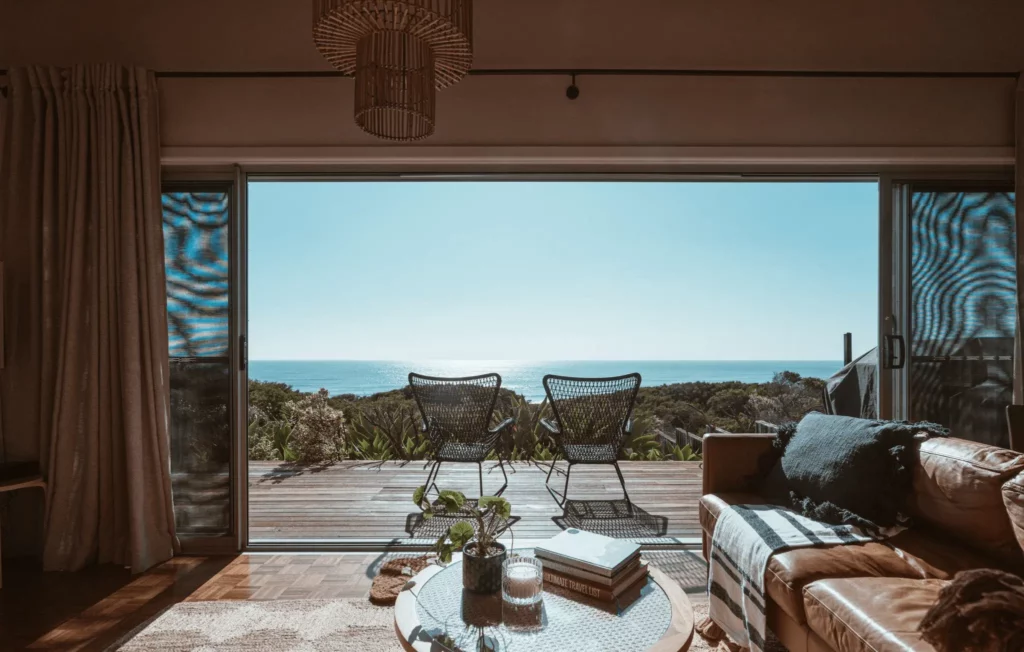
Barcelona has a wide range of accommodation options you can choose from. These accommodation options range from hotels to studio apartments, Airbnb, and co-living spaces.
Based on data from nomadlist.com, staying in a hotel will cost an average of USD 185 per night or USD 3,944 monthly. An Airbnb will cost an average of USD 132 per night. In addition, the rent of a one-bedroom studio apartment in the city averages USD 1,347 monthly.
Best neighborhoods to live in Barcelona
Some of the best neighborhoods you can settle in as a digital nomad are;
1. Gracia
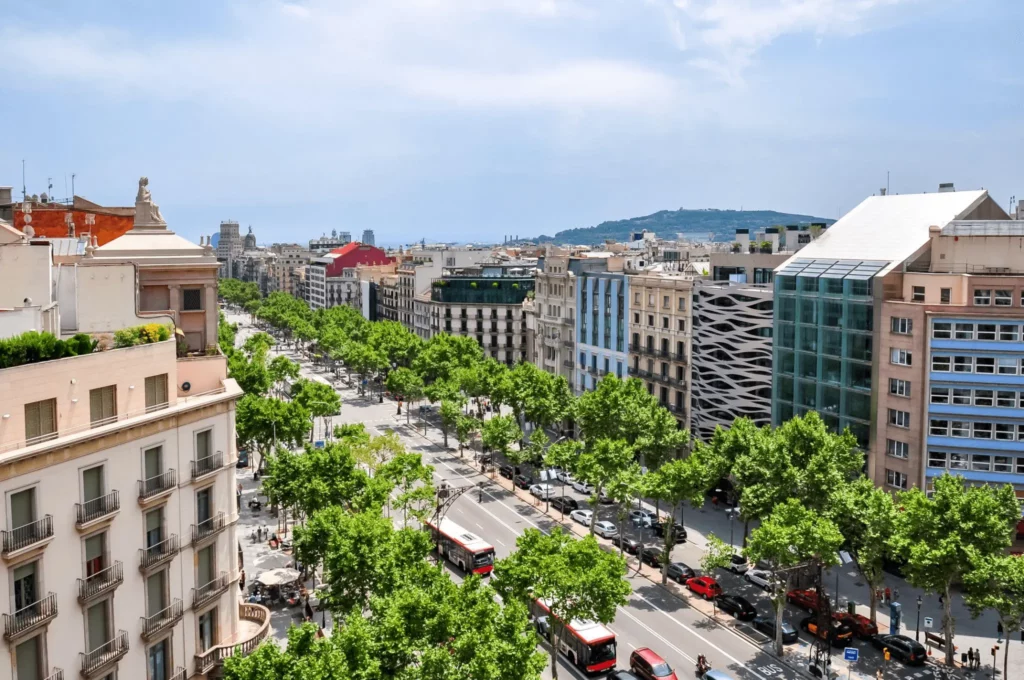
Gracia was once an independent municipality of Barcelona. Today, Gracia is a neighborhood in Barcelona. This neighborhood has a variety of restaurants, workshops, and Japanese patisseries. On top of that, it hosts yoga studios, organic food stores, and daily cultural events.
Some examples of the accommodation options within Gracia, according to booking.com, are;
2. El Born
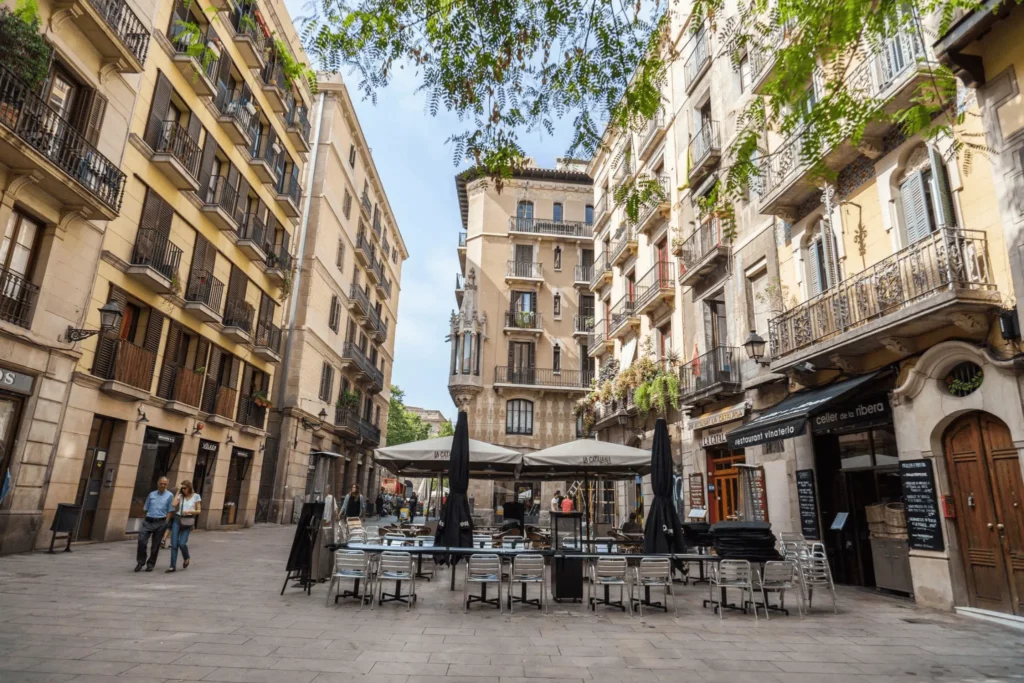
El Born is another trendy neighborhood in Barcelona. It is home to art studios and concept stores and has its own international vibe. Also, it is one of the oldest neighborhoods in Barcelona and is home to some popular landmarks.
These landmarks include Palau de la Musica, a music hall, and Basilica de Santa Maria del Mar, a Gothic church.
Some accommodations available in El Born are;
3. Barceloneta

Barceloneta is well known for its numerous beaches. This makes it a popular vacation spot and a wonderful neighborhood for tourists. Initially, Barceloneta was known as a popular fishing area, but it later changed to a neighborhood for the working class.
Unlike most parts of Barcelona, buildings in Barceloneta lack the patrician walls, thus making them unique. Also, it has a chain of nightclubs and tapas bars that host late-night parties and other beach events.
For accommodation, Barceloneta has some great options you can choose from:
Other peaceful neighborhoods to live in Barcelona are;
- The Gothic Quater (Barri Gotic)
- El Raval
- Poblenou
- L’Eixample
Utilities
While living in Barcelona, you may have to pay for utilities, especially if you are staying in a studio apartment. These include electricity, garbage collection, water, and a cooling and heating system. According to numbeo.com, living in an 85.2 sq m studio apartment will attract utilities worth USD 177.71 monthly, on average.
One-minute prepaid mobile tariff, however, will cost you USD 0.24 per month. Also, monthly unlimited internet, of speed 60mbp, will cost you USD 39.88 on average in the city.
Internet
Over the years, Spain’s internet connectivity has seen remarkable growth. As a digital nomad in Barcelona, you can seamlessly work online, especially as a remote worker. Barcelona has an average mobile download speed of 49.84 Mbps and an upload speed of 12.15 Mbps. Fixed internet speeds average 191.87 Mbps for download speed and 159 Mbps for upload speed.
Best coworking spaces in Barcelona

Some of the best coworking spaces in Barcelona are;
1. OneCowork Coworking space
Located just along the Barceloneta harbor, OneCowork is one of the best coworking spaces in Barcelona and Europe. Moreover, it has been recognized by popular magazines like Forbes.
Also, OneCowork is known for its growing community of corporate professionals, entrepreneurs, startups, and freelancers. So as a digital nomad, this is the perfect space to interact with like-minded people.
It also has essential working amenities, which include;
- Scanners and printers
- High-speed internet
- Phone booths
- Free refreshments.
This coworking space has different payment and membership plans that include:
- Daily pass – EUR 25 per person
- Flexible Desk – EUR 165/month per person
- Private office – EUR 350/month per person
2. MOB (Makers of Barcelona) Coworking space
Located in Eixample, Barcelona, MOB is a coworking space specifically for people who fall under the creative space. So, if you are a designer or photographer, this is your go-to coworking space.
In addition, one of the pioneers of MOB collaborates with FabCafe to ensure proper catering for clients. Also, for convenience, MOB has a branch in Elborn. This coworking space is home to over 300 entrepreneurs, techies, makers, and freelancers.
Amenities within this space include;
- Meeting rooms
- IT support
- High-speed Internet
- Underground parking
- Virtual office solutions.
Some of its membership and payment plans are;
- Day pass- EUR 20
- Fixed desk- EUR 220/month
- Flexible desk- EUR 110/month
3. Sowo coworking space
Located in C. del Consell de Cent, Sowo is the perfect coworking space if you are looking for a private office. Even better, these private offices are vast, around 650sq.m, and jampacked with necessary amenities.
It is open 24 hours all around the year. Also, it often holds events and training to allow networking and teach new skills to members.
Common amenities in the Sowo coworking space are;
- High-speed internet
- Scanners and printers
- Meeting rooms
- Security
Membership and payment plans include;
- Hourly rate- EUR 5
- Daily rate – EUR 18.
Other great coworking spaces in Barcelona you can work from are;
- Coworking Wekow Balmes Y Rossello
- Betahaus Coworking Space
- Cahoot Coworking space
- La Vaca Coworking Barcelona
- Star2Bee Coworking
Crypto Community
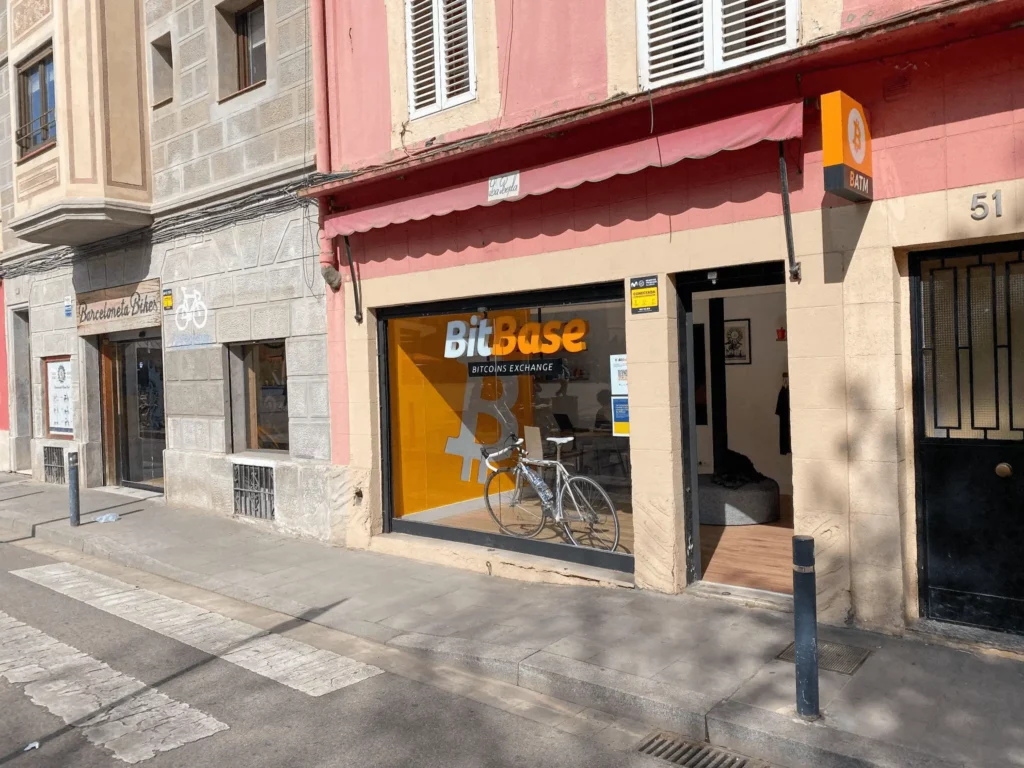
Based on a 2021 report by Triple-a.io, Spain had over 1.1 million crypto users, a 2.51% of the population.
Barcelona has seen several crypto communities rise in recent years. One of the popular crypto communities in Barcelona is Blockchain Catalunya, which aims to promote blockchain technology and its potential.
Crypto taxation
Spain’s government considers cryptocurrencies as capital assets. So, as a crypto investor, you must include your crypto gains and losses in your taxable income. Taxation for capital gains in Spain ranges between 19% to 26%.
| Capital gains (EUR) | Tax rates |
| 0 – 6,000 | 19% |
| > 6,000 – 50,000 | 21% |
| > 50,000 – 200,000 | 23% |
| > 200,000 | 26% |
Major crypto and blockchain startups in Barcelona
Barcelona have numerous crypto and blockchain startups. Some of these are:
1. Validated ID
Launched in 2012, Validated ID is Barcelona’s most established blockchain company. It has raised over EUR 5.9 million in capital.
The company started as an e-signature organization. However, with time, it expanded its services to the blockchain space and launched VIDchain, a decentralized self-rule identity that gives users control over their identity on the internet.
2. Openfort
Openfort is a blockchain startup aiming to build an infrastructure for the growing blockchain gaming industry. Thus developers can create wallets with this infrastructure to improve and empower users’ experience.
3. Rand App
Although a simple technology, the Rand wallet is meant to change how people send, earn, and spend money. It aims to make this process easier and better than what is experienced in traditional banks. Its network puts the power of finance in the users’ hands. Rand uses AI and Web3 to create this solution.
Other blockchain and crypto startups in Barcelona include:
Crypto ATMs in Barcelona
According to 2022 data from Statista, Barcelona ranks first for most installed crypto ATMs in Spain. Barcelona has 56 active crypto ATMs.
Some of these crypto ATMs include:
| Operator | Location | Cryptocurrencies supported |
| Bitnovo | Punto Bitnovo | Bitcoin |
| Bitnovo | Carrefour Las Glorias | Bitcoin |
| Bitnovo | Carrefour La Maquinista | Bitcoin |
| BitBase | Cajero Bitcoin BitBase Zona Franca | Bitcoin, Bitcoin Cash, Ether, Litecoin, Dogecoin, Tether, Ripple, |
| BitBase | Cajero Bitcoin BitBase Barcelona | Bitcoin, Bitcoin Cash, Ether, Litecoin, Dogecoin, Tether, Ripple, |
| Metodo Bitcoin | Granollers | Bitcoin |
| GBT Finance | Carrer Santa Teresa, 45 Mataró | Bitcoin, Bitcoin Cash, Ether, Monero, Dash, Zcash, Litecoin, Dogecoin |
Size of Expat community in Barcelona
Although the population of ex-pats in Barcelona may vary over time, it usually averages at 20% of the city’s population. According to data from Bcn Advisors, the number of foreigners in Barcelona in 2021 was 371,527, 22.4% of the city’s population. Also, most of this population comprises people younger than 30.
Local nomad job opportunity
With Spain’s digital nomad visa, you can work a remote job and other local jobs. However, the visa only allows nomads to make 20% of their income from Spanish businesses.
You can find some job opportunities on local job websites like Infojobs, Monster, Talent Search People, Trabajos, and Turijobs. Also, nomads can try popular international job platforms like Fiverr, Freelancer, LinkedIn, and Upwork.
Popular recreational activities and fun spots in Barcelona
While in Barcelona, you can immerse yourself in many fun activities and visit multiple recreational spots. Here are some of the activities and fun spots you can try:
1. Enjoy jet skiing

To enjoy jet skiing, head to the Port Forum and discover another perspective of Barcelona. Here you can rent a jet ski and enjoy sailing for hours in the Mediterranean blue waters.
Even without previous experience, you can ride a jet ski with guidance from professional instructors. You don’t need a license to ride these jet skis.
Renting a jet ski for 30 minutes will cost about USD 139 per person. A one-hour rental, however, will cost you around USD 222 per person. In addition, you must make a USD 108.28 deposit for safety purposes.
2. Board a hot air balloon flight

For an immersive experience in a hot air balloon flight, head to Cardedeu, Barcelona. Enjoy the beautiful landscape of Barcelona beneath you while you float high in the sky. The experience is engaging as you lend a hand during flight preparations, from setting out to inflating the balloon.
Some unique views you might come across during your flight include the Mediterranean Sea, the peaks of Montserrat, and the entire Barcelona city.
A hot air balloon flight for a group of people costs around USD 189. In contrast, a private flight goes for about USD 733.
3. Bungee jumping
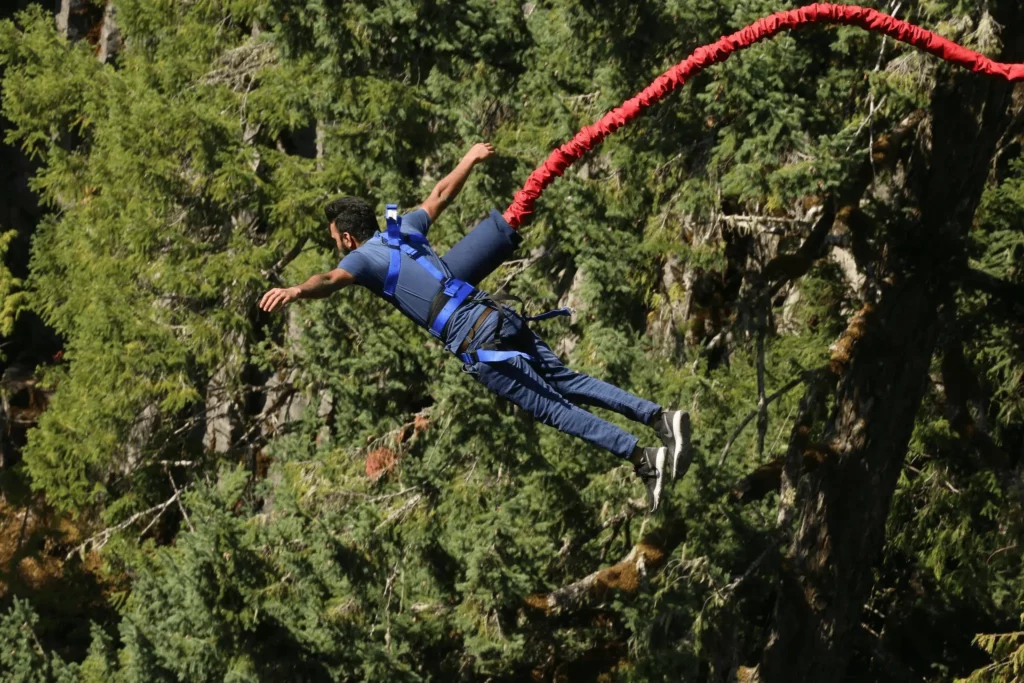
Located in Lloret de Mar, Costa Braa is Spain’s highest human slingshot (50m). Feel the thrilling sensation as you accelerate high toward the sky.
If you like adrenaline activities, you will love how fun this experience can be. There are two offers available if you want to enjoy this experience. These offers are;
- Around USD 56 with a Go Pro
- Around USD 45 without a Go Pro
Other fun activities you can enjoy while in Barcelona include:
Transportation in Barcelona
Barcelona has different forms of transportation, which include:
Air transport
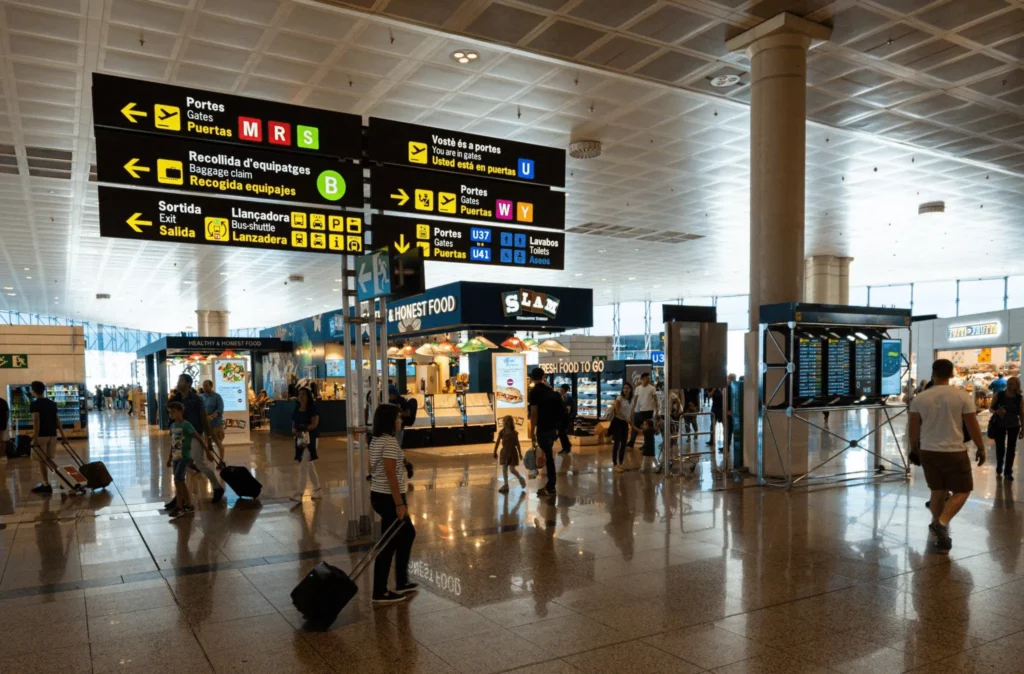
Although Barcelona has several airports, Josep Tarradellas Barcelona-El Prat Airport, or BCN Airport, is the major international airport. Located 15km from the Barcelona city center, this airport is the second largest in Spain. It covers an area of 15.33sq.km. The airport catered to around 41.6 million passengers in 2022.
Other airports in Barcelona are Reus International Airport and Girona Airport, located about 120km and 100km from the city center, respectively. Usually, these airports serve passengers traveling within the Catalonian capital.
Water transport
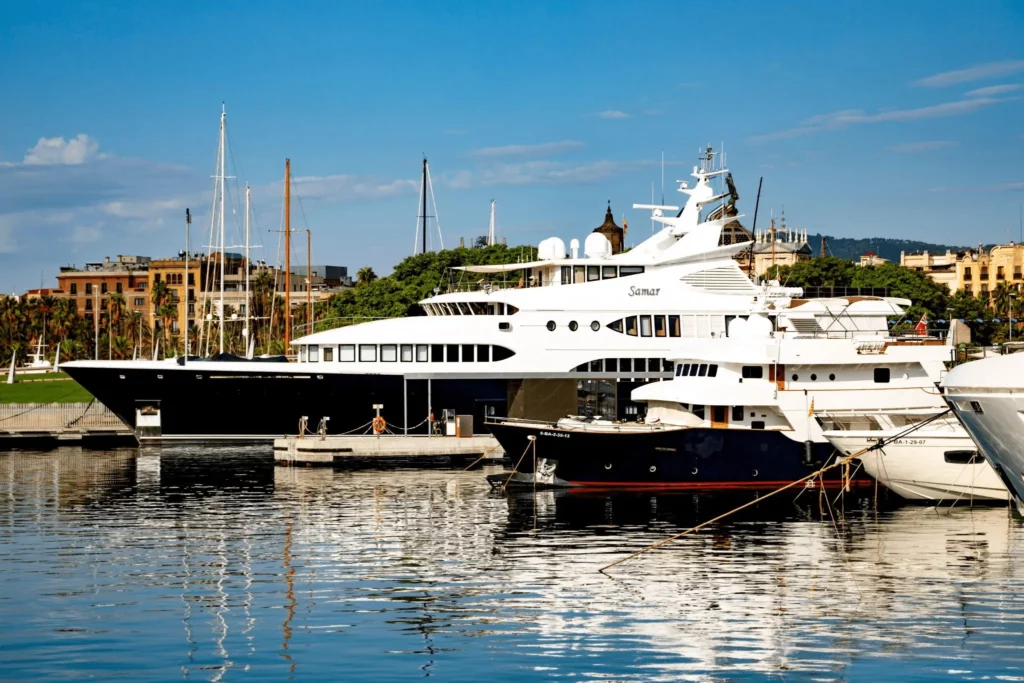
Barcelona has four main ports, Port Vell, Port Olimpic, Port Forum, Barcelona Cruise, and Cargo Port. Barcelona Cruise and Cargo Port are specifically for merchant ships, while the other three are for private use.
Ferries in these ports usually connect Spain to other destinations like Morocco, Italy, Rome, Menorca, Formentera, and Sardinia.
Some of the ferry services in Barcelona are:
Railway transport
Trains
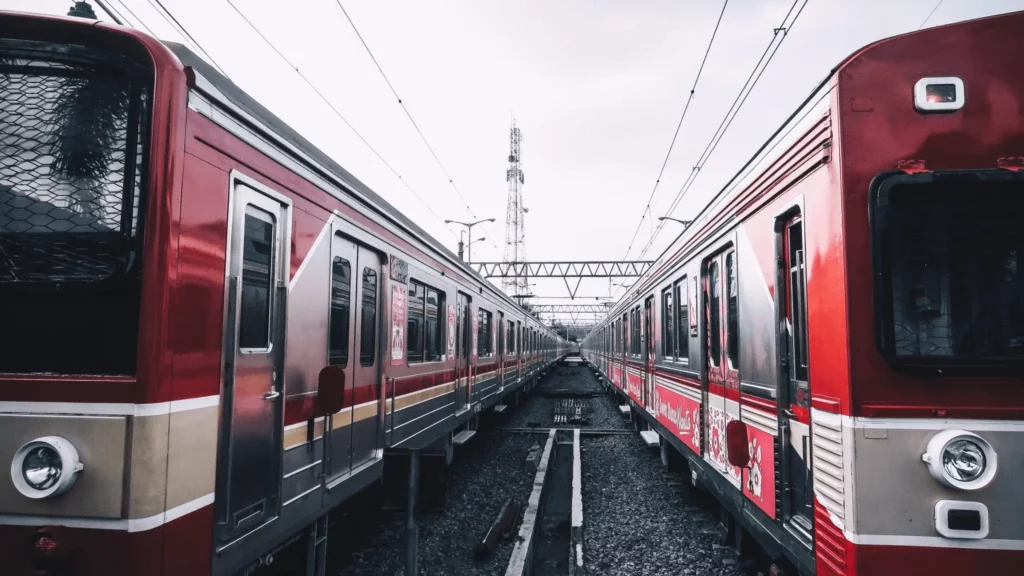
Barcelona has eight railway lines, 165 railway stations and 165 trains. The railway lines the control of two railway networks, Ferrocarrils de la Generalitat de Catalunya (FGC) and Renfe.
You can opt for a single ticket, an integrated ticket, or T-casual card. You can buy these tickets from a station ticket machine or online. The prices of these tickets vary with the type and the destination. Check out the TMB website or the station ticket machine for more information.
Most importantly, R2 Nord, one of the train lines, directly connects Barcelona to Barcelona-El Prat airport. The R2 Nord starts from Mecanet-Massenes station through Granollers and terminates at the airport. This means of transport is the cheapest way from Barcelona to the airport and vice-versa.
Trams
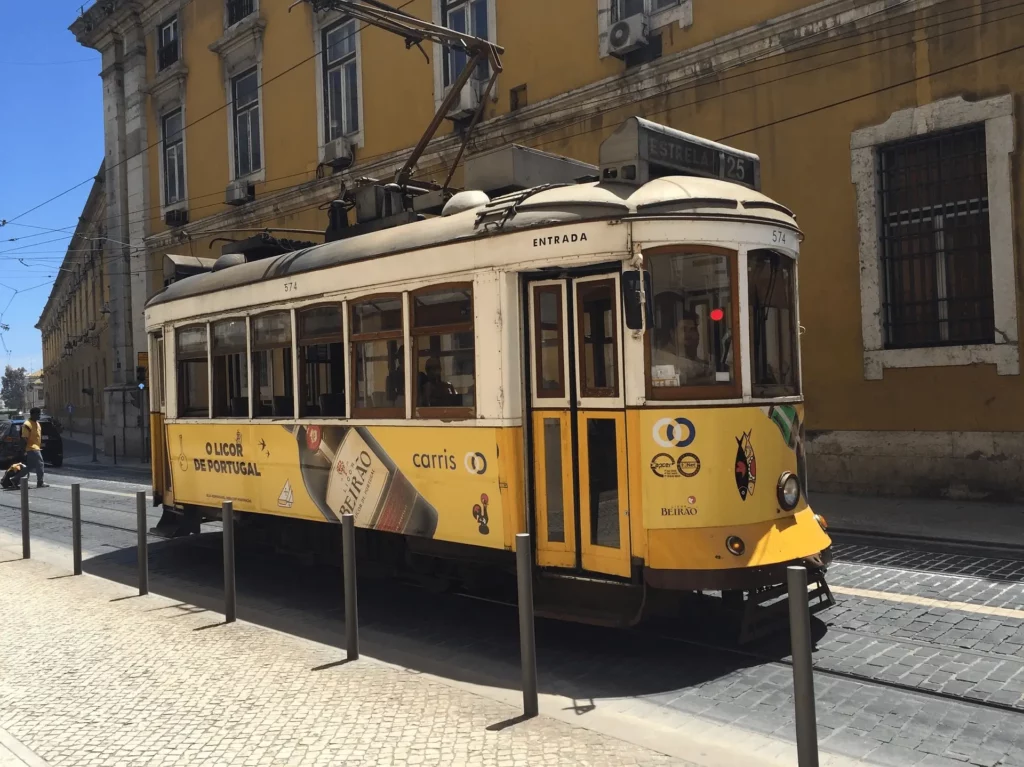
If you want to travel to the outskirt of Barcelona, trams are convenient. Barcelona has two main tram systems: the Trambesos, which connects the city to the eastern areas, and Trambaix, which connects to the western parts of the city.
Each tram station has a machine for buying tickets. Usually, a single ticket costs around USD 2.60 (EUR 2.40). After boarding, remember to validate your ticket.
Road transport
The common modes of road transport in Barcelona include:
Buses
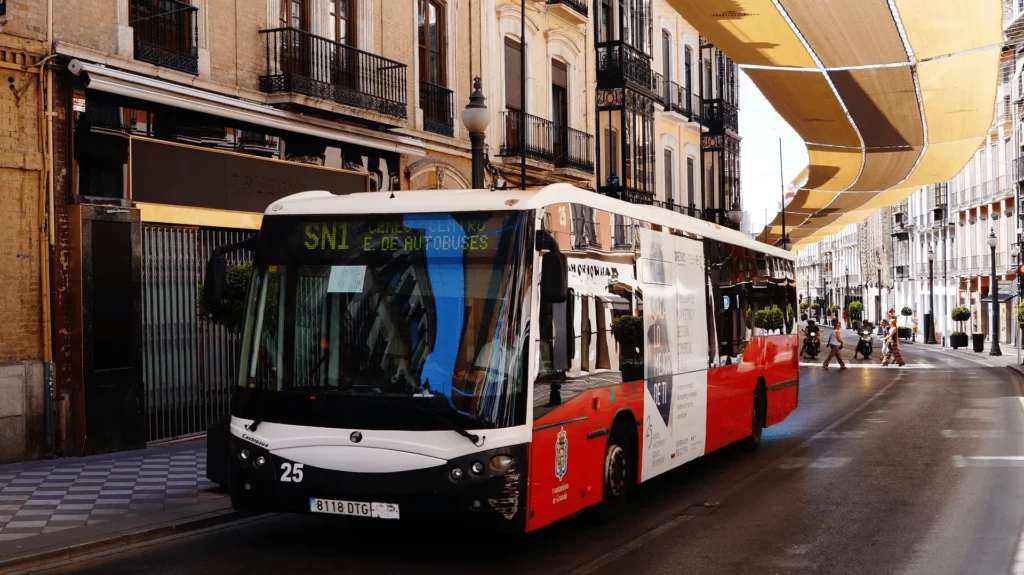
Bus transportation is a major backbone of Barcelona’s public transportation system. The city has over 1000 buses that serve over 100 routes. To spot a bus to your destination, look at the bus lines. Most buses display their lines on the front of their windshield.
The buses are available throughout, even during the night. There is a specific bus service for night transportation, the Nit Bus. Usually, the night bus service starts around 10:40 p.m. and ends at around 6 a.m.
Usually, a single bus ticket usually costs USD 2.17 (EUR 2). Also, the most common payment methods are through apps like TMB, T-Dia, and T-10.
Barcelona has a bus service, the AeroBus, links the city center to the airport. This bus service has A1 and A2 services that respectively link to Terminal 1 and Terminal 2 of Barcelona-El Prat Airport.
This bus service has two types of tickets, a one-way ticket for EUR 6.75 and a return ticket for EUR 11.65.
AeroBus has bus stops both near Barcelona-El Prat Airport and the city center. These are;
- Aeropuerto El-Prat
- Placa Espanya
- Pl. Universitat
- Gran Via-Urgell
- Sepulveda-Urgell
- Placa Catalunya (city center)
Taxis
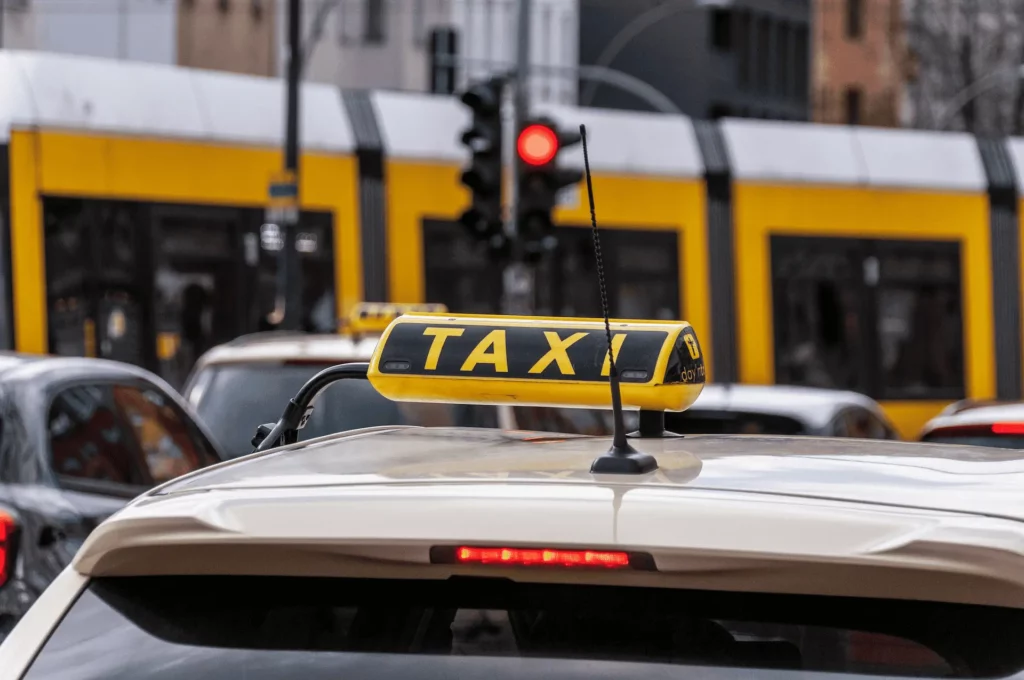
Barcelona has over 11,000 taxis, easily identifiable due to their yellow and black color.
To board a taxi in Barcelona, hail them down or order one through Uber or Cabify. The taxi network has a standardized fare system for all taxis operating in the city to avoid overcharging. The fare is usually around USD 2.22 (EUR 2.25), and you can pay using cash, credit, or the taxi app.
Bicycles
Bike riding is the cheapest means of transport in Barcelona. Also, it’s a clean, healthy, and silent way to navigate the city. For shorter distances, bicycle riding is the best transportation option.
You can rent a bike to use in the city through the following platforms:
Safety
Generally, Barcelona is a safe city. However, petty crimes like pickpocketing, bag theft, and scamming are common. One needs to take safety precautions while getting around the city.
Even though the city is also generally safe at night, one should avoid some areas like El Raval. El Raval is a den of petty crimes like bag snatchers, thefts, and drug dealers.
Most parts of Barcelona have police patrolling day and night to ensure the utmost safety of the residents.
According to numbeo.com, here is a summary of crime rates in the city.
| Safety Issue | Percentage (%) | Rating |
| Crime level | 55.29 | Moderate |
| Risk of home breakage and theft | 47.06 | Moderate |
| Risk of robbery and mugging | 57.41 | Moderate |
| Risk of car theft | 34.52 | Low |
| Risk of racial, religious. Gender and ethnic discrimination | 28.20 | Low |
| Drug dealing | 59.56 | Moderate |
| Risk of attack | 45.56 | Moderate |
Also, according to data from numbeo.com, the safety rating during the day is 68.88%, which is quite high. At night the safety rating drastically goes down to about 43.07%.
Safety tips while in Barcelona
- Always keep your purse close.
- Keep your eyes on your luggage.
- Choose a safe neighborhood to live in.
- Always carry a copy of your passport with you.
- Be alert for pickpocketers on the streets and in the metro.
- If possible, visit the beach with a friend.
- Carry your cash safely.
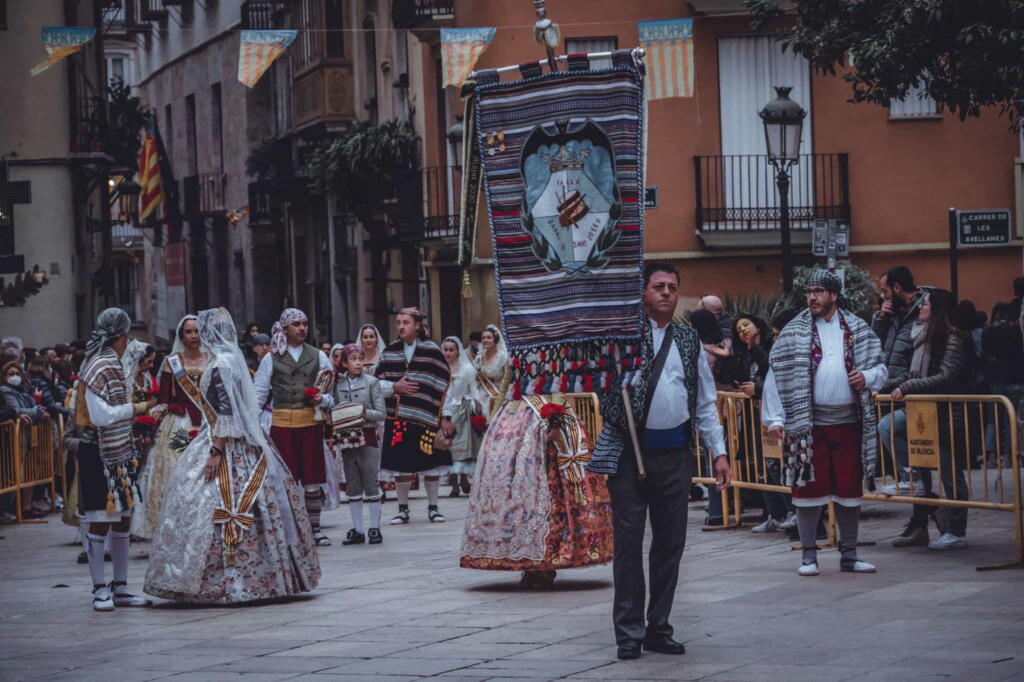
Barcelona’s culture blends modernism and traditions. This culture includes the rich Catalan Tradition, the city’s rich history, art, music, and even its tasty cuisine. Some aspects that showcase the rich culture of Barcelona are:
1. Remarkable architecture
Barcelona is home to one of the greatest architects, Antoni Gaudi. His works that embrace the area’s culture include Casa Ametller, Casa Battlo, Sagrada Familia, and La Pedrera.
2. Catalan culture
Catalan might be part of Spain’s entire culture, but it is prevalent in Barcelona. While navigating the city, you will likely stumble across different festivals in the city center. While at these festivals, you will probably see dancing sardanas and giants all over.
3. Music festivals
Barcelona constantly hosts music festivals all year. Thanks to Catalan’s appreciation of music, chances are high that you will come across music festivals for different music genres in the city.
Barcelona also has several auditoriums and theatres to host these music festivals. They include;
- Gran Teatre del Liceu: Built in the 19th century, this theatre still maintains its old splendor. Also, it has a program to exhibit major operas and works of new composers.
- The Auditori: This auditorium is home to Catalonia National Orchestra and the Barcelona Symphony. Besides focusing on its international music projects, it also has a project to promote musical culture to the locals.
- Palau Santa Jordi: This is a venue for various festivals besides music.
Other musical venues in Barcelona are Barcelona Teatre Musical and Palau de la Musica Catalana.
4. Art galleries galore
Barcelona is the heart of art in Spain. This is because the city is home to some of the most famous artists in Spain and the world. These artists include Pablo Picasso, Salvador Dali, and Joan Miro. Most galleries and museums around Barcelona display these incredible artists’ works.
Besides museums and galleries, other facilities promoting art in Barcelona are:
How to behave in Barcelona
Here are the do’s and don’ts while in Barcelona.
- Learn a few words in Catalan and Spanish.
- Do not get too political.
- Adhere to local schedules and customs. For instance, shops close during midday for lunch. Also, Spaniards eat their lunch and dinner late.
- Although not expected, hotels appreciate tipping. However, don’t tip 20% or more while dining in a restaurant.
- Take some Spanish cooking classes.
- Only take pictures in market stands and shops after asking for permission.
- Don’t buy paella for dinner. The locals consider the dish too heavy for dinner.
- Treat everyone respectfully.
- Understand the difference between Catalonia and the rest of Spain.
Barcelona’s Political and economic stability
Political nature and government
Spain consists of 17 communities and 50 provinces. Catalonia, one of the communities, has four provinces, Barcelona, Girona, Lleida, and Tarragona. Barcelona is the capital of Catalonia, while Madrid is the capital of Spain. Catalonia enjoys self-governance and experiences a stable political state.
A constitutional monarchy rules Spain, while a president rules Catalonia.
Economic indicators
Barcelona experiences a stable and lucrative economy. Barcelona’s gross domestic product (GDP) 2018 was EUR 46,600 per person.
Also, despite the Covid-19 pandemic in 2019, the GDP of Barcelona grew by 2.3%. As a result, the GDP of Catalonia also grew by 1.9% in the same year. Additionally, Barcelona is a haven for foreign investment. In 2019, it ranked seventh place among the top cities attracting foreign investments worldwide.
Barcelona’s diversified economy includes sectors ranging from food and beverages to motor vehicles, chemicals, plastics, and electronics. These industries play a significant role in the export industry of Spain. In 2019, Barcelona exported merchandise worth EUR 57,163.2 million. These exports contributed 19.7% of the entire exports in Spain. Interestingly, this was a 3.3% increase from the previous year, 2018.
Language and language barriers
The two official languages in Spain are Castilian Spanish and Catalan. 80% of Spain’s population speak Spanish, while the rest speak other local dialects. Interestingly, Spanish is one of the most widely spoken languages worldwide. It comes at number four with over 543 million speakers worldwide.
In Barcelona, both Spanish and Catalan are common. 98% of Barcelona’s population can speak Spanish, while 60% are fluent in Catalan.
Meanwhile, although English isn’t widely spoken in Barcelona, the city has seen more speakers over the years. This is thanks to the touristic nature of Barcelona. In fact, according to a 2018 demographic survey conducted in Barcelona, about 0.5% (29,000) of the population speak English.
Most foreigners visiting Barcelona prefer to communicate in English. Fortunately, most staff members in the touristic areas are familiar with the language, thus making it easy for foreigners.
Healthcare in Barcelona

The healthcare system in Barcelona has been recognized by World Health Organization (WHO) as one of the best worldwide. Indeed, the city receives over 20,000 medical tourists every year.
The public health system in Catalan offers subsidized healthcare to locals with the TSI card. To get the TSI card, you need a social security number and to register your address on Padron (a list of people living in the municipality) in a town hall near you.
Expats, however, need to have a certificate of registration (Empadronamiento) and NIE number alongside the TSI card to access the state’s healthcare.
If you are an EU, EEA, or Swiss national, you can use the EHIC (European Health Insurance Card) to access healthcare in Barcelona. UK citizens, however, must carry their GHIC (Global Health Insurance Card). To apply for the GHIC card, click here.
Also, you can grab private health insurance from some insurance companies in Spain. These companies include:
Hospitals
Barcelona has 58 Hospitals, 46 private hospitals, and 12 public hospitals. Some of the best hospitals in Barcelona are:
- Hospital del Mar
- Hospital Universitari de la all d’Hebron
- Hospital de Sant Pau
- Hospital Plato
- Hospital Universitari Dexeus
- Centro Medico Teknon
- Sant Joan de Deu Barcelona Children’s Hospital
Despite public hospitals offering high-quality healthcare, most of them are usually crowded. Therefore, if you can afford it, it’s advisable to use private healthcare facilities which offer fast services.
Vaccination
The government of Spain advises all travelers to follow the WHO and Centers for Disease Control and Prevention (CDC) recommended vaccination requirements before entering the country. These vaccinations include the following:
- Hepatitis A
- Hepatitis B
- Measles
- Meningitis
- Polio
- Tdap (Tetanus, Diphtheria, and Pertussis)
- Influenza
- Chickenpox
- Pneumonia
- Rubella
- Shingle
- Covid-19
- Rabies
On top of the vaccinations, carrying a traveler’s diarrhea kit is advisable in case of stomach upsets.
Electronic standards

Spain operates on a power supply of 230V and at a frequency of 50Hz. The standard socket plugs, however, are type C and type F. Type C socket plugs only have two round pins. Meanwhile, type F plugs have two round pins and, on the sides, two earth clips.
Regarding telecommunication networks, Spain operates on GSM (Global System for Mobile Communication). Unfortunately, your phone might not work in Spain if you are from Asia, the US, or countries operating on CDMA (Code Division Multiple Access).
Telephone and Internet plans
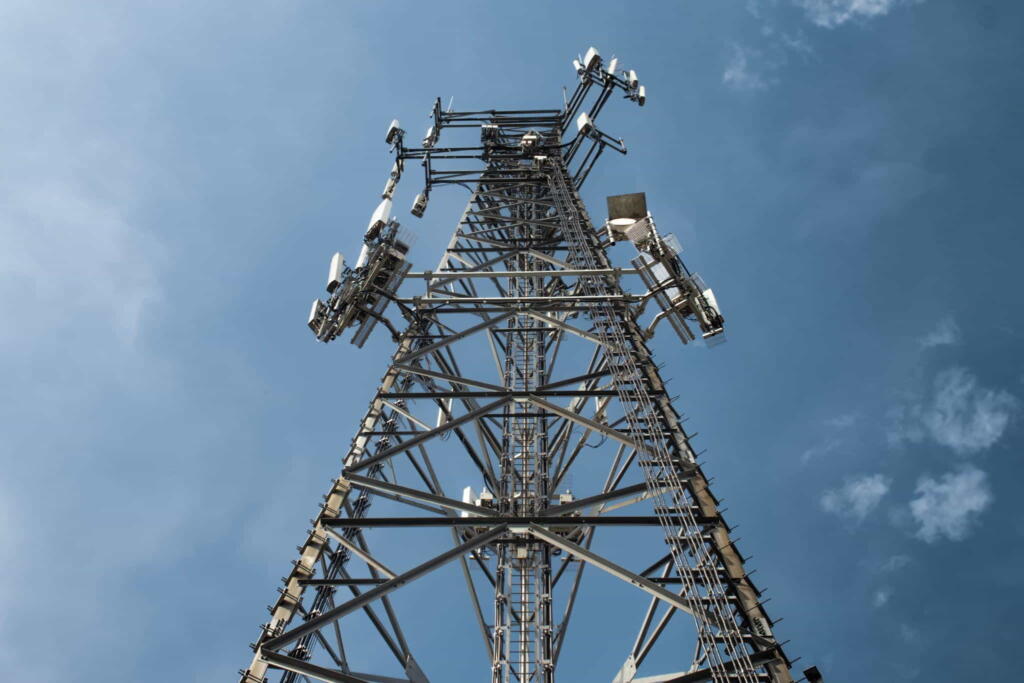
Spain has four main mobile networks. They are:
In 2022, Opensignal, a private standard for analyzing mobile experiences, released findings of its data collection on Spain’s mobile networks. These findings included the following:
- Movistar had the best consistent mobile experience. According to the Opensignal data, this mobile network has taken the lead twice, in a row, for core consistency.
- Movistar has topped for the best overall mobile speeds. Its download speed averaged 35.4 Mbps, while the upload speed was 11.2 Mbps.
- Vodafone, Yoigo, and Orange have taken the lead for best availability. These mobile networks tied at scores between 98.2% – 98.3%. This means that the subscribers of these mobile networks spend the most time connected to their networks.
- Movistar subscribers had the best video experience. Out of 100 points, Movistar scooped 56.1 points, while the rest scooped less.
- Yoigo, Movistar, and Orange tied for the 5G availability and reach. Subscribers to these networks spend the most time connected to 5G.
These mobile networks have different mobile plans. So, you can check their official websites for more information about their mobile plans.
Payment service and infrastructure

Similar to many countries worldwide, Spain also embraces digital payment methods. In 2020, a report by the Bank of Spain showed that 54.1% of Spaniards preferred paying with debit cards, while 35.9% preferred cash payments. Meanwhile, 64.8% of businesses opted for debit card payments, while 26.4% of small businesses preferred cash payments.
Another survey conducted in 2021 showed over 50% of e-commerce shoppers preferred paying with debit cards. Another 40% preferred other digital payment methods like PayPal.
Spaniards use similar payment methods for both domestic and international payment methods. These methods include:
- Credit and debit cards – Most preferred are Visa and Mastercard
- Bank transfers – Popular options are Sofort and Trustly
- E-wallets: Examples include Bizum, Cofidis, Apple Pay, Click to Pay, SEPA Direct Debit, Paypal, Multibanco, and Google Pay
- Cash and cheque payments.
- Buy Now, Pay Later (BNPL) – Popular contenders are Klarna and Clearpay
Currencies, and exchange rate
The Euro is Spain’s official currency. As of 31st March 2023, the prevailing currency exchange rate was 1 Euro equals USD 1.09.
Climate and seasons
Spain mostly experiences sunny days with about 3000 hours of sunshine annually. Temperatures are moderate but can vary with seasons. Seasons experienced in Spain are spring, summer, autumn, and winter.
Spring and autumn have the mildest temperatures allowing for long hours of outdoor activities. Summer and winter also allow outdoor recreational activities but only for short hours.
Meanwhile, Barcelona experiences a Mediterranean climate. Compared to other coastal resorts in Spain, Barcelona has warmer winters and less hot summers.
For heat lovers, the best time to travel to Barcelona is during the summer. In summer, Barcelona experiences ten or more hours of sunshine daily. Winters, however, are mild, with less snow and frost.
In addition, the city experiences a relatively dry climate throughout the year, with October and November experiencing frequent rains.
Below is a summary of the climatic condition in Barcelona every month of the year.
| Month | Climate Condition |
| January | Barcelona experiences mild winters and less snow and frosts. |
| February | Usually the driest month. Temperatures feel similar to Britain during spring. |
| March | High air temperatures, although comfortable. Sea temperatures average around 14°C. Swimming and other recreational water activities are less. The best month to visit because of fewer crowds and shorter queues. |
| April | Warm sunshine. Sea temperatures average around 15°C and are still chilly for recreational activities. |
| May | It is the best time to visit Catalonia before the temperature gets hotter in July and August. |
| June | Pleasant month for swimming and other recreational water activities. Sea temperatures average 22°C. Daylights are long-lasting, from 6.00 am to 9.30 pm. |
| July | It is summertime. Low humidity. Temperatures might reach 30°C, but a steady breeze helps keep them relatively comfortable. The temperature at night is also high. |
| August | Temperatures are still high. So, stay under the shade and apply sunscreen while outside. It’s a good time to enjoy beach activities. |
| September | Sea temperatures average around 24°C. The best month for recreational water activities. It is the wettest due to frequent rains. |
| October | Temperatures are cooler, and sea temperature falls to around 22°C. It’s also a wet month with more rain than average. |
| November | It’s autumn, and temperatures are mild and comfortable. It’s a dry month and warm enough to explore fun outdoor activities. |
| December | It is relatively warm. Also, the daylight hours are short-lasting, from 8.00 am to 5.00 pm. |
Cuisine in Barcelona
Some tasteful cuisines you might want to try out in Barcelona are;
Paella
Although the dish originates from Valencia, it is also common in Barcelona. This dish comprises rice, stock, peas, tomatoes, garlic, and sherry. It also includes saffron and paprika.
Croquettes
Although you can eat it alone, the locals usually prefer to serve it as part of a larger dish. It is a ball-like dish of mashed potatoes, ham, and sauce coated with breadcrumbs. This ball is then deep-fried before being served.
Patatas Bravas
This dish consists of potato cubes fried twice and served with a sauce. The sauce is made of garlic, tomato, and lemon. The frying makes the potatoes crispy on the outside and soft on the inside.
Fideua
Although similar to Paella, Fideua replaces rice with noodles. Other ingredients include bell pepper, fish stock, saffron, paprika, garlic, tomato, and some seafood. The seafood options include mussels, squid, and shrimp clams.
Tortilla de Patatas
Outside Spanish regions, it’s also known as a Spanish tortilla or Spanish omelet. It consists of eggs, potatoes, onions, and olive oil.
Other types of cuisines you can try out are;
Tax requirements on digital nomads
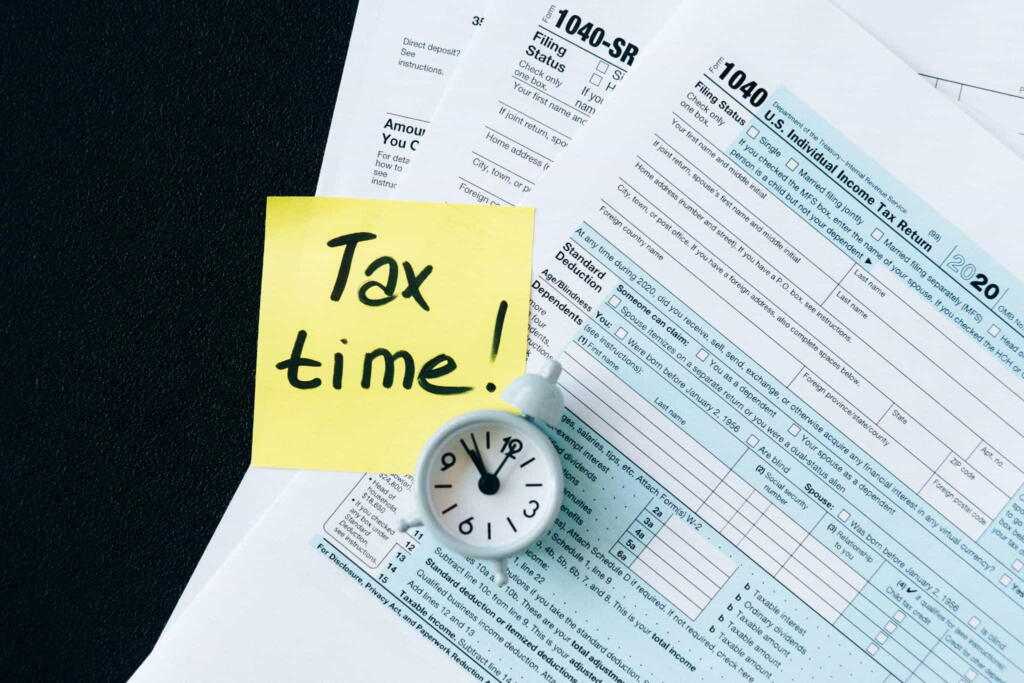
Thanks to the digital nomad visa, digital nomads only need to pay tax for income obtained from Spanish organizations. Usually, this is a tax rate of 24% for income up to EUR 600,000 and 47% for any income above that.
You should submit your tax return if you own property in Spain. These taxes range between 8% to 11.5% for different properties.
Common concerns about Barcelona
Some of the major concerns ex-pats have about Barcelona are:
- Spaniards use Sundays as a relaxation day, a day to meet and interact with family and friends. So, there are no open markets, shops, stores, or malls.
- Salaries in Barcelona are low as EUR 1,200 per month. Also, getting a work permit in the city isn’t easy.
- Rental prices are high.
- Administrative procedures are slow, especially when obtaining a residence permit.
- The city is incredibly noisy.
In conclusion, despite the few negatives, Barcelona is a remarkable city for ex-pats. Also, it offers a friendly and conducive working environment for digital nomads.
Always check with local country websites for the most up to date visa, health, tax and travel requirements before entering a country. This article is general information and does not constitute legal advice, check with a legal professional for visas, working visas, applicable tax and crypto laws specific to you.

